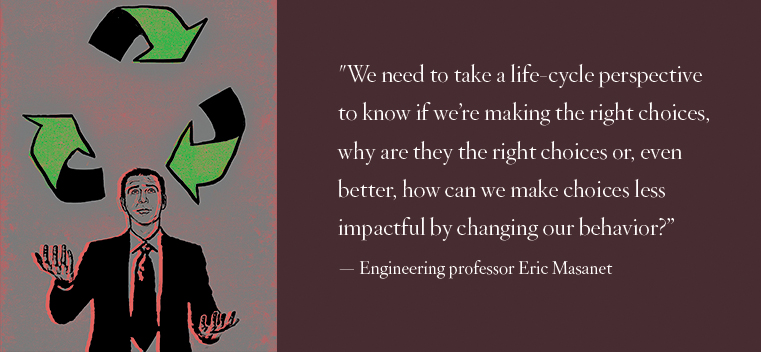
Full Cycle
Tell us what you think. E-mail comments or questions to the editors at letters@northwestern.edu.
Ever wonder about those strange designations we use throughout Northwestern to identify alumni of the various schools of the University? See the complete list.
Find Us on Social Media
Life-cycle assessment expert looks for sustainable solutions.
Everyone loves the Keurig coffee maker. But that cup of fresh-brewed java comes at an environmental cost. The single-serve portions come in plastic pods that can’t be recycled. Are the old-fashioned drip coffee makers more environmentally friendly?
Well, Eric Masanet says, it depends. “Those single-serve coffee makers are more energy efficient because they heat just the amount of water you need for one cup,” he says. “So sure, that drip maker doesn’t generate plastic waste, but it uses more energy. It’s a perfect example of where we need to take a life-cycle perspective to know if we’re making the right choices, why are they the right choices or, even better, how can we make choices less impactful by changing our behavior?”
Masanet (GMcC96), associate professor of mechanical engineering and of chemical and biological engineering, looks at everything this way — quantifying energy usage, emissions and environmental effects of current and potential products, technologies and behaviors — and he’s training Northwestern engineering graduate students to do the same. The Energy and Resource Systems Analysis Laboratory, which he leads, is using life-cycle assessments (LCA) to improve design and manufacturing, inform policymakers and make the world a more sustainable place.
For example, Masanet’s team is looking at the move from newsprint to digital news. Society is already making the transition, but Masanet knows from earlier work with paper mills that the newspaper manufacturing base has become much more efficient in the last several years.
“With digital,” says Masanet, “if you read around an hour per day of news on a smartphone or a laptop, then the digital does look more sustainable than printed news — lower carbon emissions, lower energy use. But we found that the more you read, the narrower this gap gets between paper and digital.
“In general, it’s probably a good thing to shift to digital news, and we can use these models to make recommendations to manufacturers and policymakers about what actions they can incentivize.”
Masanet and his team are also in the third year of a project to advise the Department of Energy’s Office of Advanced Manufacturing on how to evaluate its research and development investments. On one project he’s putting together a prospective life-cycle model looking specifically at additive manufacturing, a 3D-printing process that can be used to manufacture metal parts with novel geometries. For example, Airbus is building a bracket for an airplane layer by layer from titanium powder, rather than machining it down from a titanium block.
“The additive manufacturing process itself is pretty energy intensive,” admits Masanet, “but there are savings because you don’t have to use nearly as much titanium to make a part. And those new parts, given their strength and unique geometries, can make aircraft even lighter.”
Additive manufacturing may use more energy and cost more for the manufacturer, “but we’re saving all these resources upstream and we’re saving all this fuel downstream. So if you draw the box around a manufacturer, it might be hard to justify moving to this new technology. But if you draw the box around society, like we do with LCA, then you see it’s a slam dunk.”
Masanet, who worked in manufacturing before earning his doctorate at the University of California, Berkeley, and working at the Lawrence Berkeley National Laboratory, says LCA modeling is crucial at the intersection of policy, manufacturing and sustainability.
For nearly two years now Masanet has worked on a project for the California Environmental Protection Agency’s Air Resources Board, leading a Northwestern team that examined tomato canning, dairy processing and other food industries to inform policymakers how to divvy up emissions allowances in the state’s cap-and-trade policy.
“It requires modeling of the way energy and mass moves in these facilities,” says Masanet. “If you don’t start with the right analysis basis, you may not be rewarding plants in the right way, and then it’s less effective than it could be.”
Masanet hopes to launch an outreach initiative to have engineering students perform LCAs for local small and medium-size manufacturers to create a free database of LCA results. He is also teaching a course through Northwestern’s partnership with Coursera on LCA ("How Green Is that Product? An Introduction to Life Cycle Environmental Assessment"), which he hopes will generate interest in the growing field.



 Facebook
Facebook Twitter
Twitter Email
Email


